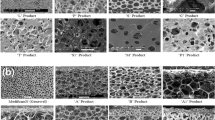Abstract
Background
Negative pressure wound therapy (NPWT) is becoming routine for the preparation of wounds prior to grafting for wound closure. With this purpose, we have been using both foam and gauze-based NPWT obtaining similar proportions of closed wounds and observing less pliable scar tissue on the foam-treated patients. The aim of this study was to compare this two different fillers and to identify if there are different indications for their use according to anatomical areas in relation to the type of granulation and scar tissue obtained.
Methods
Both foam and gauze patients were compared in terms of depth and wound location, patients' age, and comorbidities. All foam patients were treated at 125 mmHg for an average of 25 days before skin grafting, while gauze patients were treated at 80 mmHg for an average of 21 days before skin grafting. Biopsies of granulation and scar tissues were taken and stained with hematoxylin-eosin and Masson's trichrome stainings, investigating vascular endothelial growth factor (VEGF) and metalloproteinase (MMP). An ultrasound analysis of the closed wounds was also conducted.
Results
Histological, immunohistochemical, and ultrasonographical results after gauze-based NPWT showed a minor tissue thickness and disorganization and less sclerotic components.
Conclusions
These results support the hypothesis that different fillers generate different scar tissues. The choice of the filler to apply negative pressure should be dictated by the anatomical areas affected by the lesion.
Level of Evidence: Level IV, therapeutic study.




Similar content being viewed by others
References
Fraccalvieri M, Zingarelli E, Ruka E, Antoniotti U, Coda R, Sarno A, Bocchiotti MA, Bruschi S (2011) Negative pressure wound therapy using gauze and foam: histological, immunohistochemical and ultrasonography morphological analysis of the granulation tissue and scar tissue. Preliminary report of a clinical study. Int Wound J 8(4):355–364
Kairinos N, Solomons M, Hudson DA (2009) Negative-pressure wound therapy I: the paradox of negative-pressure wound therapy. Plast Reconstr Surg 123(2):589–598, discussion 599–600
Labler L, Rancan M, Mica L, Härter L, Mihic-Probst D, Keel M (2009) Vacuum-assisted closure therapy increases local interleukin-8 and vascular endothelial growth factor levels in traumatic wounds. J Trauma 66(3):749–757
Erba P, Ogawa R, Ackermann M, Adini A, Miele LF, Dastouri P, Helm D, Mentzer SJ, D’Amato RJ, Murphy GF, Konerding MA, Orgill DP (2011) Angiogenesis in wounds treated by microdeformational wound therapy. Ann Surg 253(2):402–409
Scherer SS, Pietramaggiori G, Mathews JC, Prsa MJ, Huang S, Orgill DP (2008) The mechanism of action of the vacuum-assisted closure device. Plast Reconstr Surg 122(3):786–797
Gibson D, Cullen B, Legerstee R, Harding KG, Schultz G (2009) MMPs Made Easy. Wounds International. 1(1)
Mouës CM, van Toorenenbergen AW, Heule F, Hop WC, Hovius SE (2008) The role of topical negative pressure in wound repair: expression of biochemical markers in wound fluid during wound healing. Wound Repair Regen 16(4):488–494
Martins VL, Caley M, O'Toole EA (2013) Matrix metalloproteinases and epidermal wound repair. Cell Tissue Res 351(2):255–268
Wu TH, Hsu SH, Chang MH, Huang YY (2013) Reducing scar formation by regulation of IL-1 and MMP-9 expression by using sustained release of prednisolone-loaded PDLL microspheres in a murine wound model. J Biomed Mater Res A 101(4):1165–1172
Gawronska-Kozak B (2011) Scarless skin wound healing in FOXN1 deficient (nude) mice is associated with distinctive matrix metalloproteinase expression. Matrix Biol 30(4):290–300
Malmsjo M, Ingemansson R, Martin R, Huddleston E (2009) Negative-pressure wound therapy using gauze or open-cell polyurethane foam: similar early effects on pressure transduction and tissue contraction in an experimental porcine wound model. Wound Rep Reg 17:200–205
Borgquist O, Gustafsson L, Ingemansson R, Malmsjo M (2010) Micro- and macromechanical effects on the wound bed of negative pressure wound therapy using gauze and foam. Ann Plast Surg 64:789–793
Fraccalvieri M, Ruka E, Bocchiotti MA, Zingarelli E, Bruschi S (2011) Patient’s pain feedback using negative pressure wound therapy with foam and gauze. Int Wound J 8(5):492–499
Fraccalvieri M, Pristerà G, Zingarelli E, Ruka E, Bruschi S (2012) Treatment of chronic heel osteomyelitis in vasculopathic patients. Can the combined use of Integra®, skin graft and negative pressure wound therapy be considered a valid therapeutic approach after partial tangential calcanectomy? Int Wound J 9(2):214–220
Fraccalvieri M, Fierro MT, Salomone M, Fava P, Zingarelli EM, Cavaliere G, Bernengo MG, Bruschi S (2012) Gauze-based negative pressure wound therapy: a valid method to manage pyoderma gangrenosum? Int Wound J. doi:10.1111/j.1742-481X.2012.01058.x
Ethical Standards
The study has been approved by the appropriate ethics committee and have therefore been performed in accordance with the ethical standards laid down in the 1964 Declaration of Helsinki and its later amendments. Patients gave their informed consent prior to their inclusion in the study. Details that might disclose the identity of the subjects under study were omitted.
Conflict of interest
None
Author information
Authors and Affiliations
Corresponding author
Rights and permissions
About this article
Cite this article
Fraccalvieri, M., Scalise, A., Ruka, E. et al. Negative pressure wound therapy using gauze and foam: histological, immunohistochemical, and ultrasonography morphological analysis of granulation and scar tissues. Eur J Plast Surg 37, 411–416 (2014). https://doi.org/10.1007/s00238-014-0964-2
Received:
Accepted:
Published:
Issue Date:
DOI: https://doi.org/10.1007/s00238-014-0964-2




